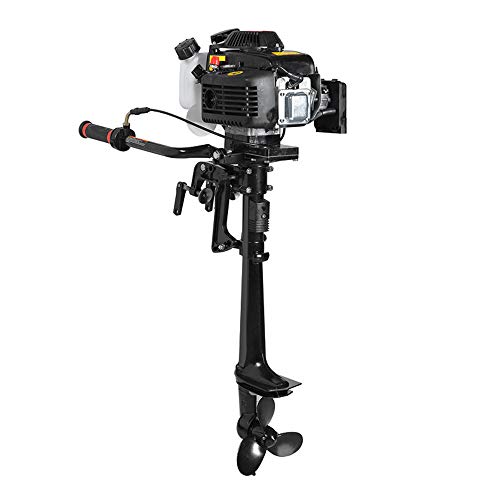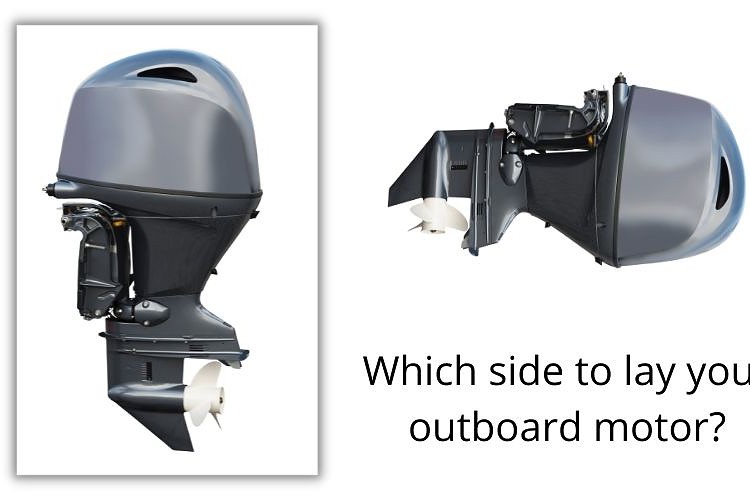You just bought a new outboard motor for your boat. You’re ready to head out to the lake and start testing it out.
Just one question: how do you get it there safely?
Of course, you could install it on your boat and transport it, boat and all, to the lake. But if your boat is already at the lake, you may need to transport the motor independently.
So, how do you do that? Can you transport an outboard motor on its side?
Keep reading! We’ll answer these questions and more throughout this article.
Table of Contents
Can You Transport an Outboard Motor On Its Side?

As with many things, the short answer is, it depends. It’s impossible to make a blanket statement because there are many different styles and brands of outboard motors, and what works for one may not work for another.
In some cases, the answer is yes–you can transport the motor on its side. But this will almost certainly depend on the type and design of the motor and the manufacturer. Always check with your owner’s manual and follow the recommendations included in it.
It’s also a good idea to look for a diagram or any written instructions on the side of the motor itself. These diagrams or written instructions are sometimes included to show how you can lay the motor down properly and safely.
There are two broad categories of outboard motors, 2-stroke and 4-stroke. Generally speaking, 2-stroke motors are much more suited for being transported on the side than 4-stroke motors. Again, though, there may be exceptions to the rule.
Let’s take a closer look at 2-stroke and 4-stroke motors.
2-Stroke Motor

2-stroke motors can generally get transported on their side, especially over short distances. You can also transport them over longer distances, but it’s best to completely drain them of fuel, water, oil, and any other liquids before doing so.
What if you have no time to drain these fluids? How long can the motor be laid on its side without leaking or sustaining damage?
Most 2-stroke motors should be okay if laid on their side for a few hours without draining them. Beyond half a day or so, you may have to start worrying about leaks.
Again, look at your owner’s manual; some outboard motor brands recommend never storing or transporting the motor on its side, while others recommend draining all fluids first, and still others don’t specify.
When in doubt, play it safe. If your manual says nothing about laying the motor on its side, your best bet may be to assume that you shouldn’t lay it on its side.
4-Stroke Motor

4-stroke motors have a newer outboard motor design, but newer isn’t necessarily better. 4-stroke motors are not as good for transporting on the side.
In general, you should never transport a 4-stroke on its side because there is an extremely high risk of fluid leaks. Even if you thoroughly drain the motor first, transporting and storing them on their side can cause problems over time.
Some 4-stroke motors can be transported on their back, but even then, they must be drained first. They should also be properly secured, so they don’t roll around in the back of your car or truck.
Again, it’s extremely important to look at your owner’s manual and explore the motor for a diagram on the side or back. If you can’t find anything about laying the motor on its side or back, assume that it is unsafe to do so, even for short periods of time.
On Which Side Should You Lay Your Outboard Motor?

Every manufacturer does things a little differently; not all outboard motors will be the same in this regard.
If it’s okay to lay the motor on its side, the owner’s manual will give this information along with the recommended side you should lay it on. Generally speaking, you will lay it on whichever side is flat.
Again though, it’s best not to lay it on the side unless the manual specifically says you can.
After checking the manual, check the motor as well. Look for diagrams or labels that indicate you can lay on that specific side.
With some motors, you can lay them on either side; with others, you can lay them on one side but not the other. Again, it all depends on the motor’s manufacturer and design.
How Long Can an Outboard Motor Lay On Its Side?

Like all the questions in this article, the answer depends on the type of motor. If you have a 2-stroke motor, it’s generally safe to lay it on its side for extended periods, particularly if all fluids have been drained.
If the fluids have not been drained, you shouldn’t leave your 2-stroke motor on its side for more than a few hours, or up to half a day.
Depending on how far you have to go, this might be a long enough time to safely transport the motor. If you have more of an extended trip, or if you’re looking to store the motor on its side, it is imperative that you drain the motor first.
If the fluids have been drained, it should be okay to store the motor on its side as long as the owner’s manual says you can. Don’t assume; always find out the proper way to store your motor.
With a 4-stroke motor, you should never place it on its side unless the fluids are drained, not even for short periods. Even if you have drained the motor, you should only transport the motor on its side if the manual says you can, and only for short distances.
You should never store a 4-stroke motor on its side.
If you have a 4-stroke motor, it may be best to invest in a motor stand that will hold the motor upright both for transport and storage.
What is the Best Way to Transport an Outboard Motor?

Simply put, the best way to transport an outboard motor is whatever way the owner’s manual recommends. Usually, it’s best to transport it upright using a stand or in its stored position on the boat.
If you are transporting the motor on its side, it’s best to transport it in a pickup truck bed so the motor won’t damage the interior of your vehicle. Keep it tied down so it doesn’t roll around, as this could damage the motor and cause fluid leaks.
But what if you don’t have a pickup? What if it’s more convenient for you to transport the motor inside your car?
How Do You Transport an Outboard Motor in a Car?
It might help to watch a tutorial video above before getting started, though keep in mind that your process may vary slightly depending on the type of motor you have as well as the type and size of the car.
You may want to first cover your car seats with towels or other protective coverings. You may need to fold the seats down, so you have enough room for the motor.
Drain all the fluid from your motor, even if you have a 2-stroke that doesn’t technically need to be drained before transporting. You don’t want any chance of the motor leaking and damaging your seats.
Lay the motor on the proper side according to your owner’s manual and any diagrams on the motor itself. Strap it down using seat belts or other straps if available–you don’t want it rolling around the back of your car or rolling off the seats.
Once you’re done transporting the motor, remove it immediately and put it in storage.
Conclusion
Some outboard motors can be laid on their side, but it’s important to check with your owner’s manual first before transporting the motor that way. Depending on the style or manufacturer, you may need to drain the fluids first or only place them on a specific side before you can safely transport them.

Sarah Hood has been writing for Anchor Travel since 2021. When she’s not writing, she enjoys cooking, singing, and spending time in the great outdoors.

